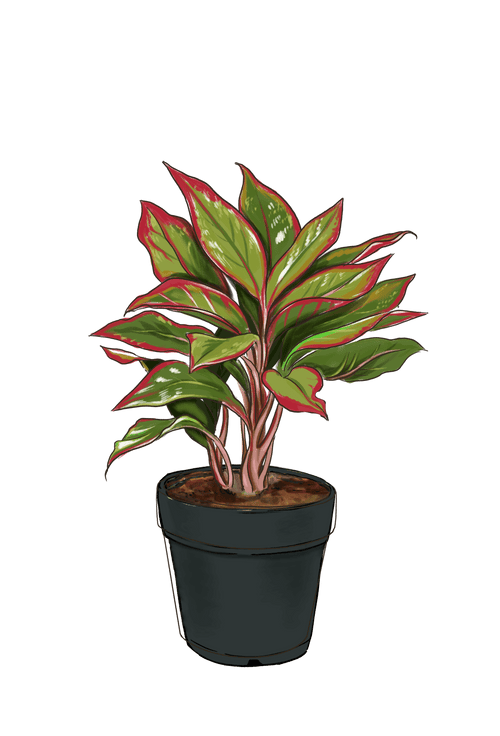Aglaonema Care Guide

-
Light : Medium
Medium to bright indirect light. Never direct sunlight.
-
Water : Medium
Let the soil dry between waterings.
-
Humidity : Low
No extra humidity required.
-
Temp : 68℉ - 77℉
They prefer the indoor temperatures between 68-77°F but no lower than 60°F or it will experience some cold damage.
-
Zone : 10|11
Outside: Grow in full shade where nights are above 60°F.
Indoors: The Chinese evergreen can tolerate low lit rooms but will maintain their variegated details better in medium to bright, indirect light. Fluorescent and grow lights are also an option.
-
Fertilizer : Yearly
The Chinese evergreen doesn't need much food. Water the plant before fertilizing to avoid fertilizer burn. Fertilize once in the spring and summer by diluting a liquid fertilizer, using half the recommended strength into the water. Let the plant rest in the fall and winter.
-
Repotting : 3 Years
When receiving the plant, do not repot immediately but wait at least 6-12 months. They like to be a bit root-bound.
Repot in the spring, using a 2" bigger pot to keep the roots drier. (Too big of a pot could cause the soil to dry slower, which is not helpful.) Use a well-draining indoor potting mix with perlite to help with drainage.
Place a piece of screening at the bottom of the container over the drainage hole to secure the soil and allow drainage. Add soil to the bottom to elevate the root ball. Lift the plant and release the roots against the existing planter. Use a clean knife or garden trowel to wedge between the pot and the soil to loosen.
Inspect the root ball. Notice if there are any dead or rotting roots and trim off with sterile pruners. If the plant is rootbound, cut through the roots to alleviate continued encircling.
Ensure the plant is sitting about 1" below the edge of the pot to avoid water spillage. Add more soil and backfill around the sides by tamping down. Fill up to the soil line but not over.
Water thoroughly, leaving the soil damp but not soggy. If settling occurs, add more soil.
-
Cleaning : Monthly
Spritz the leaves with lukewarm water and gently wipe or dab clean with a soft cloth or paper towel. Work gently from the base of the stem toward the tip of the leaf steadying the leaf blade in your palm as you wipe. After cleaning the leaves, remove any dead leaves or debris on the surface of the soil. Trim off any yellowing leaves at the base of the plant. Refresh soil mixture if it has settled.
-
Propagation : Division|Stem Cutting
In the spring or summer, prune stem cuttings from the parent plant in inconspicuous places.
Cut off several inches in length, dip in root hormone (mixed in water at a paste consistency) and place in damp, well-draining, moist potting soil mix and tamp down around the stem to secure them.
Use a container that has drainage and is deep enough for the roots to grow. Plant at least 1-2 inches down into the soil.
Mist inside a clear plastic bag to create moisture and humidity. Place the bag over the top of the plantings and let it set over the planter. There is no need to tie off the bag but allow a little airflow under and into the planting pot.
Set them in medium, indirect sunlight while they are rooting.
Check the moisture and humidity each day and add misting to keep the soil moist while the roots establish.
After 6-8 weeks, roots will begin to form. You can tug onto the stem to ensure the roots are establishing.
Another way is to take the cutting and place in water. Replace the water weekly and observe the growth each week. Once you have several healthy roots, place in soil with rooting hormone sprinkled on the roots to help get established.
If several stalks are in the pot, divide the plants from the mother plants by gently removing the soil and separating the roots. Repot the new plants in smaller pots with indoor potting mix. Water and set in low to medium light while they get settled and mature.
Note: Wear gloves while handling this plant. The sap contains calcium oxalate crystals which can cause blistering, swelling and dermatitis on the skin.















